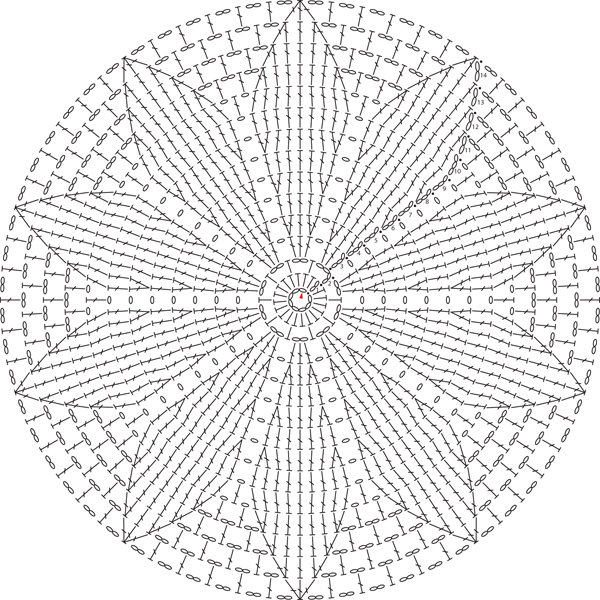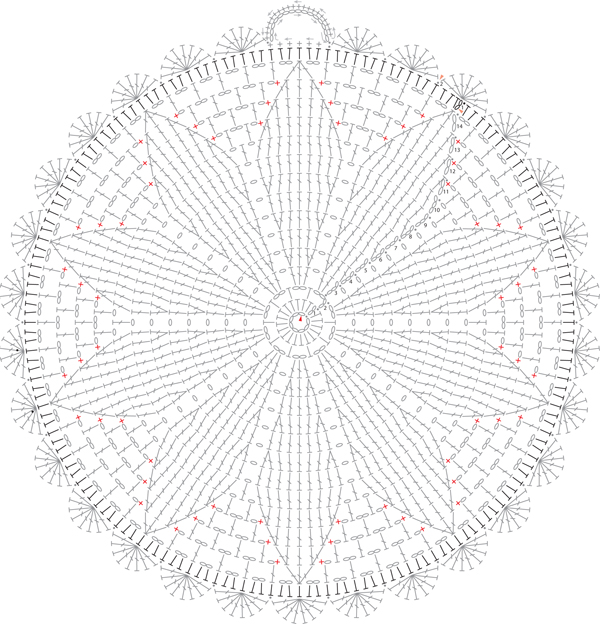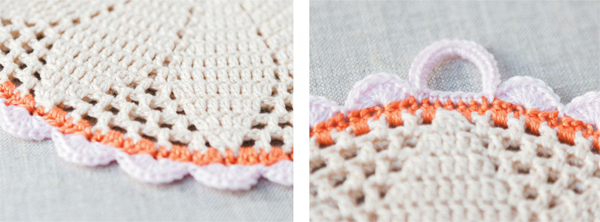
Traditional filet crochet designs are most often seen worked in rows using treble crochet and chain stitches to create a mesh-like grid, and by filling the spaces with more treble stitches an array of interesting patterns can be produced. However, the same idea can just as easily be applied to circular motifs, using densely placed treble stitches and increases separated by that familiar open mesh work as can be seen on my Filet Daisy Potholder. It is worked in two layers and the petals of the daisy motif are aligned with joining double crochet stitches to maximize the beautiful filet effect.


Back panel
Any standard 4ply (fingering) weight cotton yarn can easily be substituted for the stated yarn; however, checking your tension carefully beforehand is strongly recommended.
jdc = a double crochet stitch to join the front and back sections of the potholder worked as follows: double crochet into corresponding ch-sp on same round of back section, either immediately before or after tr2tog st of the petal motif
7 rnds in tr sts (12st increase each rnd) = 10cm (4in)
23cm (9in) diameter (excluding hanging loop)
When you come to join the two panels together with jdc stitches, take care to ensure that you are working into the correct row of the back panel. If you are unsure, you could mark the appropriate stitches on each row with a different coloured stitch marker or scrap yarn. Use the symbols shown on the front panel chart as a guide.
Foundation ring: using yarn A and 3mm hook ch8, ss to form ring
Round 1: ch2 (counts as first htr), 19htr into ring, ss into 2nd of starting ch2
Round 2: ch4 (counts as first htr, ch2), *miss one st of prev rnd, htr into next st, ch2* rep from * to * 9 times, ss into 2nd of starting ch4
Round 3: ss into ch-sp, ch3 (counts as first tr), 2tr into ch-sp, *ch1, 3tr into next ch-sp * rep from * to * 9 times, ch1, ss into 3rd of starting ch3
Round 4: ch3, tr into base of ch3 (counts as first 2tr inc), tr, 2tr inc, *ch1, miss ch-sp of prev rnd, 2tr inc, tr, 2tr inc * rep from * to * 9 times, ch1, ss into 3rd of starting ch3
Round 5: ch3 (counts as first tr), tr into 4sts, *ch1, miss ch-sp of prev rnd, tr into 5sts* rep from * to * 9 times, ch1, ss into 3rd of starting ch3
Round 6: ch3, tr into base of ch3 (counts as first 2tr inc), tr into 3sts, 2tr inc, *ch1, miss ch-sp of prev rnd, 2tr inc, 3tr, 2tr inc* rep from * to * 9 times, ch1, ss into 3rd of starting ch3
Round 7: ch3 (counts as first tr), tr into 6sts, *ch1, miss ch-sp of prev rnd, tr into 7sts* rep from * to * 9 times, ch1, ss into 3rd of starting ch3
Round 8: ch3, tr into base of ch3 (counts as first 2tr inc), tr into 5sts, 2tr inc, *ch1, miss ch-sp of prev rnd, 2tr inc, 5tr, 2tr inc* rep from * to * 9 times, ch1, ss into 3rd of starting ch3
Round 9: ch3 (counts as first tr), tr into 8sts, *ch1, miss ch-sp of prev rnd, tr into 9sts* rep from * to * 9 times, ch1, ss into 3rd of starting ch3
Round 10: ch3 (counts as first tr), tr into 8sts, *†ch1, tr into ch-sp, ch1†, tr into 9sts* rep from * to * 9 times, rep from † to † once more, ss into 3rd of starting ch3
Round 11: ch2, tr into next st (counts as first tr2tog), *†tr into 5sts, tr2tog, ch2, [tr into ch-sp, ch2] twice†, tr2tog* rep from * to * 9 times, rep from † to † once more, ss into top of first tr
Round 12: ch2, tr into next st (counts as first tr2tog), *†tr into 3sts, tr2tog, ch2, [tr into ch-sp, ch2] 3 times†, tr2tog* rep from * to * 9 times, rep from † to † once more, ss into top of first tr
Round 13: ch2, tr into next st (counts as first tr2tog), *†tr, tr2tog, ch2, [tr into next ch-sp, ch2] 4 times†, tr2tog* rep from * to * 9 times, rep from † to † once more, ss into top of first tr
Round 14: ch2, tr2tog (counts as first tr3tog), *†ch2, [tr into next ch-sp, ch2] 5 times†, tr3tog* rep from * to * 9 times, rep from † to † once more, ss into top of first tr2tog, fasten off

Front panel with edging
This panel is joined to the back panel by sewing the two pieces together at the centre, then joining as you go with joining dc (jdc) sts in rounds 11 to 13.
First: leaving a 30cm (12in) tail of yarn at the beginning, work as given for back panel to the end of rnd 10
Next: lay the back and front panels together, with WS facing, and line up the stitch pattern at the centre. Whip stitch through the centre hole and htr sts of rnd 1; fasten off yarn between the two panels and weave in the loose end
Round 11: line up the petals of the daisy motif and continue with ch3, tr into next st (counts as first tr2tog), *†tr into 5sts, tr2tog, jdc into corresponding ch-sp on rnd 11 of back panel, ch1, tr into ch-sp, ch2, tr into next ch-sp, ch1, jdc†, tr2tog* rep from * to * 9 times, rep from † to † once more, ss into top of first tr
Round 12: ch3, tr into next st (counts as first tr2tog), *†tr into 3sts, tr2tog, jdc, ch1, [tr into ch-sp, ch2] twice, tr into next ch-sp, ch1, jdc†, tr2tog* rep from * to * 9 times, rep from † to † once more, ss into top of first tr
Round 13: ch3, tr into next st (counts as first tr2tog), *†tr into next st, tr2tog, jdc, ch1, [tr into ch-sp, ch2] 3 times, tr into next ch-sp, ch1, jdc †, tr2tog* rep from * to * 9 times, rep from † to † once more, ss into top of first tr
Round 14: work as given for back panel, fasten off
All of the sts in rnd 1 of the edging are worked through corresponding sts and ch-sps of both back and front panels together.
Round 1: with front panel facing join yarn B in the top of any tr3tog st (of both back and front panels), ch2, htr into base of ch2, [2htr into ch-sp, htr into next st] 59 times, 2htr into ch-sp, ss into 1st htr (180sts), fasten off
Round 2: join yarn C in 4th htr st of prev rnd, *miss 2sts, 8tr scallop into next st, miss 2sts, ss into next st* rep from * to * twice
Hanging loop: dc into 6sts, ch15, working backwards ss into same space as prev ss, working forwards 20dc into ch-sp, ss into same space as 6th dc
Continue round 2: *miss 2sts, 8tr scallop into next st, miss 2sts, ss into next st* rep from * to * 27 times (29 scallops + 1 hanging loop), fasten off and weave in loose ends
Using a press cloth, steam press on reverse with a hot iron.
